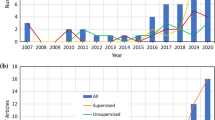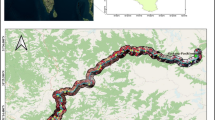Abstract
Ethiopia has a mountainous landscape which can be divided into the Northwestern and Southeastern plateaus by the Main Ethiopian Rift and Afar Depression. Debre Sina area is located in Central Ethiopia along the escarpment where landslide problem is frequent due to steep slope, complex geology, rift tectonics, heavy rainfall and seismicity. In order to tackle this problem, preparing a landslide susceptibility map is very important. For this, GIS-based frequency ratio (FR) and logistic regression (LR) models have been applied using landslide inventory and the nine landslide factors (i.e. lithology, land use, distance from river & fault, slope, aspect, elevation, curvature and annual rainfall). Database construction, weighting each factor classes or factors, preparing susceptibility map and validation were the major steps to be undertaken. Both models require a rasterized landslide inventory and landslide factor maps. The former was classified into training and validation landslides. Using FR model, weights for each factor classes were calculated and assigned so that all the weighted factor maps can be added to produce a landslide susceptibility map. In the case of LR model, the entire study area is firstly divided into landslide and non-landslide areas using the training landslides. Then, these areas are changed into landslide and non-landslide points so as to extract the FR maps of the nine landslide factors. Then a linear relationship is established between training landslides and landslide factors in SPSS. Based on this relationship, the final landslide susceptibility map is prepared using LR equation. The success-rate and prediction-rate of FR model were 74.8% and 73.5%, while in case of LR model these were 75.7% and 74.5% respectively. A close similarity in the prediction and validation rates showed that the model is acceptable. Accuracy of LR model is slightly better in predicting the landslide susceptibility of the area compared to FR model.
Similar content being viewed by others
References
Abay A, Barbieri G (2012) Landslide Susceptibility and Causative Factors Evaluation of the Landslide Area of Debresina, in the Southwestern Afar Escarpment, Ethiopia. Journal of Earth Science and Engineering 2: 133–144
Abebe B, Dramis F, Fubelli G, et al. (2010) Landslides in the Ethiopian highlands and the rift margins. Journal of African Earth Sciences 56(4-5): 131–138. DOI: 10.1016/j.jafrearsci. 2009.06.006
Akgun A, Bulut F (2007) GIS-based landslide susceptibility for Arsin-Yomra (Trobzon, North Turkey) region. Environmental Geology 51(8): 1377–1387. DOI: 10.1007/s00254-006-0435-6
Alkhasawneh MS, Ngah UK, Tay LT, et al. (2013) Determination of important topographic factors for landslide mapping analysis using MLP Network. Hindawi Publishing Corporation. The Scientific World Journal Volume 2013, Article ID 415023. DOI: 10.1155/2013/415023
Allison PD (2001) Logistic Regression Using the SAS System: Theory and Application. Wiley Interscience, New York, USA. p 28.
Atkinson PM, Massari R (1998) Generalized linear modeling of landslide susceptibility in the Central Apennines. Computers and Geosciences 24(4): 373–385. DOI: 10.1016/S0098-3004(97)00117-9
Ayalew L (1999) The effect of seasonal rainfall on landslides in the highlands of Ethiopia. Bulletin of Engineering Geology and the Environment 58(1): 9–19.
Ayalew L, Yamagishi H (2005) The application of GIS-based logistic regression for Landslide susceptibility mapping in the Kakuda-Yahiko Mountains, Central Japan. Geomorphology 65(1-2): 15–31. DOI: 10.1016/j.geomorph.2004.06.010
Bai SB, Wang J, Lv GN, et al. (2010) GIS-based logistic regression for landslide susceptibility mapping of the Zhongxian segment in the Three Gorges area, China. Geomorphology 115: 23–31. DOI: 10.1016/j.geomorph.2009. 09.025
Bui DT, Pradhan B, Lofman O, et al. (2012) Landslide susceptibility assessment at Hoa Binh Province of Vietnam using Frequency Ratio Model. In: Proceedings of the 2012 Asia Pacific Conference on Environmental Science and Technology Advances in Biomedical Engineering (APEST 2012) held in Kuala Lumpur, Malaysia, 1-2 February 2012. Vol.6, pp 476–484.
Carrara A (1983) Uncertainty in Evaluating Landslide Hazard and Risk. In: Nemec J, Nigs JM, Siccardi F (Eds.), Prediction and Perception of Natural Hazards, Kluwer, Dordrecht, The Netherlands, pp 101–111.
Carson MA, Kirkby MJ (1972) Hillslope Form and Process. Cambridge University Press, London, UK. pp 475.
Chen et al. (2013) Research based on geographical environment unit division based on the method of natural breaks (Jenks). In: Proceedings of the International Archives of the Photogrammetry, Remote Sensing and Spatial Information Sciences, Volume XL-4/W3, 2013 ISPRS/IGU/ICA Joint Workshop on Borderlands Modelling and Understanding for Global Sustainability Beijing, China, 5-6 December 2013.
Chung CJF, Fabbri AG (2003) Validation of Spatial Prediction Models for Landslide Hazard Mapping. Natural Hazards 30(3): 451–472.
Clerici A, Perego S, Tellini C, et al. (2006) A GIS-based automated procedure for landslide susceptibility mapping by the Conditional Analysis method: the Baganza valley case study (Italian Northern Apennines). Environmental Geology 50(7): 941–961. DOI: 10.1007/s00254-006-0264-7
Dai FC, Lee CF (2002) Landslide characteristics and slope instability modeling using GIS, Lantau Island, Hong Kong. Geomorphology 42(3-4): 213–228. DOI: 10.1016/S0169-555X(01)00087-3
Geographic Information Technology Training Alliance (GITTA, 2011) Classification of data. Available online: http://www.gitta.info/Statistics/en/html/StandClass_learnin gObject2.html (Accessed on 20 May 2015).
Gerscovich DMS, Vargas EA, De Campos TMP (2006) On the evaluation of unsaturated flow in a natural slope in Rio de Janeiro, Brazil. Engineering Geology 88(1-2): 23–40. DOI: 10.1016/j.enggeo.2006.07.008
Global Data Explorer (powered by GeoBrain) -USGS. Availabele online: http://gdex.cr.usgs.gov/gdex/(Accessed on 25 July 2013)
Guzzetti F, Carrara A, Cardinali M, et al. (1999) Landslide hazard evaluation: a review of current techniques and their application in a multi-scale study, central Italy. Geomorphology 31(1-4): 181–216. DOI: 10.1016/S0169-555X (99)00078-1
Ibrahim J (2011) Landslide assessment and hazard zonation in Mersa and Wurgessa, North Wollo, Ethiopia. Unpublished Master Thesis, School of Graduate Studies, Addis Ababa University, Addis Ababa, Ethiopia, pp 1–10.
Lee S (2007) Application and verification of fuzzy algebraic operators to landslide susceptibility mapping. Environmental Geology 52(4): 615–623. DOI: 10.1007/s00254-006-0049-y
Lee S, Pradhan B (2007) Landslide hazard mapping at Selangor, Malaysia using frequency ratio and logistic regression models. Landslides 4(1): 33–41. DOI: 10.1007/s10346-006-0047-y
Lee S, Ryu JH, Kim LS (2007) Landslide susceptibility analysis and its verification using likelihood ratio, logistic regression and artificial neural network models: case study of Youngin, Korea. Landslides 4(4): 327–338. DOI: 10.1007 10346-007-0088-x
Lee S, Sambath T (2006) Landslide susceptibility mapping in the Damrei Romel area, Cambodia using frequency ratio and logistic regression models. Environmental Geology 50(6): 847–855. DOI: 10.1007/s00254-006-0256-7
Lee S, Talib JA (2005) Probabilistic landslide susceptibility and factor effect analysis. Environmental Geology 47(7): 982–990. DOI: 10.1007/s00254-005-1228-z
Lee S (2005a) Application and cross-validation of spatial logistic multiple regression for landslide susceptibility analysis. Geosciences Journal 9(1): 63–71.
Lee S (2005b) Application of logistic regression model and its validation for landslide susceptibility mapping using GIS and remote sensing data. International Journal of Remote Sensing 26(7): 1477–1491. DOI: 10.1080/01431160412331331012
Lee S, Talib JA (2005) Probablistic landslide susceptibility and factor effect analysis. Environmental Geology 47(7): 982–990. DOI: 10.1007/s00254-005-1228-z
Lee S, Min K (2001) Statistical analysis of landslide susceptibility at Yongin, Korea. Environmental Geology 40(9): 1095–1113. DOI: 10.1007/s002540100310
Mapping GIS Data. Available online: http://www.columbia. edu/~dms2203/readings/03-mastering-arcgis-chapter2-mapping-gis-data.pdf. (Accessed on 16 March 2015)
Meinhardt M, Fink M, Tunschel H (2015) Landslide susceptibility analysis in central Vietnam based on an incomplete landslide inventory: Comparison of a new method to calculate weighting factors by means of bivariate statistics. Geomorphology 234: 80–97. DOI: 10.1016/j.geomorph.2014.12.042
Menard S (1995) Applied logistic regression analysis. Sage University Paper Series on Quantitative Applications in Social Sciences, 106. Thousand Oaks, California, USA. p 98.
Mezughi TH, Akhir JM, Rafek AG, et al. (2012). Analytical Hierarchy Process Method for Mapping Landslide Susceptibility to an Area along the E-W Highway (Gerik-Jeli), Malaysia. Asian Journal of Earth Sciences 5: 13–24. DOI: 10.3923/ajes.2012.13.24.
Ohlamacher GC (2007) Plan curvature and landslide probability in regions dominated by earth flows and earth slides. Engineering Geology 91(2-4): 117–134. DOI: 10.1016/j.enggeo. 2007.01.005
Ohlmacher GC, Davis JC (2003) Using multiple logistic regression and GIS technology to predict landslide hazard in northeast Kansas, USA. Engineering Geology 69(3-4): 331–343. DOI: 10.1016/S0013-7952(03)00069-3
Pradhan AMS, Kim YT (2014) Relative effect method of landslide susceptibility zonation in weathered granite soil: a case study in Deokjeokri Creek, South Korea. Natural Hazards 72: 1189–1217. DOI: 10.1007/s11069-014-1065-z
Pradhan B (2010) Landslide Susceptibility mapping of a catchment area using frequency ratio, fuzzy logic and multivariate logistic regression approaches. Journal of the Indian Society of Remote Sensing 38(2): 301–320.
Pradhan B (2011) Manifestations of an advanced fuzzy logic model coupled with Geo-information techniques to landlside susceptibility mapping and their comparison. Environmental and Ecological Statistics 18(3): 471–493. DOI: 10.1007/s10651-010-0147-7
Regmi AD, Devkota KC, Yoshida K, et al. (2014) Application of frequency ratio, statistical index, and weights-of-evidence models and their comparison in landslide susceptibility mapping in Central Nepal Himalaya. Arabian Journal of Geosciences 7(2): 725–742 DOI: 10.1007/s12517-012-0807-z
Ruff M, Czurda K (2008) Landslide susceptibility analysis with a heuristic approach in the Eastern Alps (Vorarlberg, Austria). Geomorphology 94(3-4): 314–324. DOI: 10.1016/j.geomorph.2006.10.032
Schicker R, Moon V (2012) Comparison of bivariate and multivariate statistical approaches in landslide susceptibility mapping at a regional scale. Geomorphology 161-162: 40–57. DOI: 10.1016/j.geomorph.2012.03.036
Shahabi H, Khezri S, Ahmad BB, et al. (2014) Landslide susceptibility mapping at central Zab basin, Iran: A comparison between analytical hierarchy process, frequency ratio and logistic regression models. Catena 115: 55–70. DOI: 10.1016/j.catena.2013.11.014
Temesgen B, Mohammed U, Korme T (2001) Natural Hazard Assessment Using GIS and Remote Sensing Methods, with Particular Reference to the Landslides in the Wondogenet Area, Ethiopia. Physics and Chemistry of the Earth Part C: Solar Terrestrials & Planetary Science (C) 26(9): 665–615.
Wilson JP, Gallant JC (2000) Terrain analysis principles and applications. Wiley, New York, USA.
Woldearegay K (2008) Characteristics of large-scale landslide triggered by heavy rainfall in Tarmaber area, Central Highlands of Ethiopia, Geophysical Research Abstracts, Vol. 10, EGU2008-A-04506, 2008, SRef-ID:1607-7962/gra/EGU2008-A-04506.
Yalcin A, Reis S, Aydinoglu A, et al. (2011) A GIS-based comparative study of frequency ratio, analytical hierarchy process, bivariate statistics and logistic regression methods for landslide susceptibility mapping in Trabzon, NE Turkey. Catena 85(3): 274–287. DOI: 10.1016/j.catena.2011.01.014
Yesilnacar E, Topal T (2005) Landslide susceptibility mapping: a comparison of logistic regression and neural networks methods in a medium scale study, Hendek region (Turkey). Engineering Geology 79(3-4): 251–266. DOI: 10.1016/j.enggeo.2005.02.002
Yilmaz I (2009) Landslide susceptibility mapping using frequency ratio, logistic regression and artificial networks and their comparison: A case study from Kat landslides (Tokat-Turkey). Computer & Geosciences 35 (2009) 1125–1138. DOI: 10.1016/j.cageo.2008.08.007.
Yilmaz I, Keskin I (2009) GIS based statistical and physical approaches to landslide susceptibility mapping (Sebinkarahisar, Turkey). Bulletin of Engineering Geology and the Environment 68(4): 459–471. DOI: 10.1007/s10064-009-0188-z
Zhu L, Huang J (2006) GIS-based logistic regression method for landslide susceptibility mapping in regional scale. Journal of Zhejiang University SCIENCE A 7(12): 2007–2017. DOI: 10.1631/jzus.2006. A2007
Author information
Authors and Affiliations
Corresponding author
Additional information
http://orcid.org/0000-0002-1529-190X
http://orcid.org/0000-0002-9783-5033
http://orcid.org/0000-0002-6028-1436
Rights and permissions
About this article
Cite this article
Meten, M., Bhandary, N.P. & Yatabe, R. GIS-based frequency ratio and logistic regression modelling for landslide susceptibility mapping of Debre Sina area in central Ethiopia. J. Mt. Sci. 12, 1355–1372 (2015). https://doi.org/10.1007/s11629-015-3464-3
Received:
Accepted:
Published:
Issue Date:
DOI: https://doi.org/10.1007/s11629-015-3464-3




